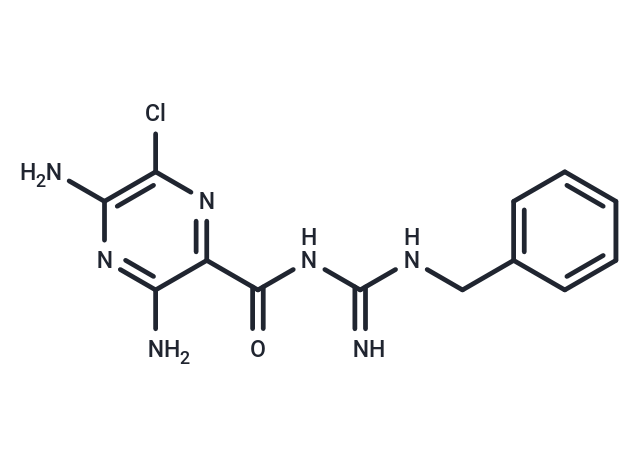Shopping Cart
- Remove All
 Your shopping cart is currently empty
Your shopping cart is currently empty

Benzamil is an epithelial sodium channel (ENaC) blocker that inhibits sodium transport from (IC50 = 4 nM) and binds to (Kd = 5 nM) bovine kidney cortex membrane vesicles.

| Pack Size | Price | Availability | Quantity |
|---|---|---|---|
| 5 mg | $50 | In Stock | |
| 10 mg | $60 | In Stock | |
| 25 mg | $126 | In Stock | |
| 50 mg | $239 | In Stock | |
| 100 mg | $432 | In Stock | |
| 1 mL x 10 mM (in DMSO) | $73 | In Stock |
| Description | Benzamil is an epithelial sodium channel (ENaC) blocker that inhibits sodium transport from (IC50 = 4 nM) and binds to (Kd = 5 nM) bovine kidney cortex membrane vesicles. |
| In vivo | nd also examined the role of ASICs on modulation of neuropathic pain.?Neuropathic pain was induced by L4-5 spinal nerve ligation in male Sprague-Dawley rats weighing 100-120 g, and intrathecal catheterization was performed for drug administration.?The effects of amiloride and benzamil were measured by the paw-withdrawal threshold to a mechanical stimulus using the up and down method.?The expression of ASICs in the spinal cord dorsal horn was also analyzed by RT-PCR.?Intrathecal amiloride and benzamil significantly increased the paw withdrawal threshold in spinal nerve-ligated rats (87%±12% and 76%±14%, P=0.007 and 0.012 vs vehicle, respectively).?Spinal nerve ligation increased the expression of ASIC3 in the spinal cord dorsal horn (P=0.01), and this increase was inhibited by both amiloride and benzamil (P<0.001 in both).?Intrathecal amiloride and benzamil display antinociceptive effects in the rat spinal nerve ligation model[1]. |
| Animal Research | On the day of the experiment, rats were allocated into experimental and control groups for the tested drugs.?Control groups were performed using intrathecal DMSO (n=5) or methanol (n=5) according to the solvent used for the tested drugs.?All experiments were performed by investigators blinded to the treatment.?To assess the effects of both drugs, increasing doses of amiloride (1, 3, 10 μg in 10 μL, n=5-7) or benzamil (3, 10, 30 μg in 10 μL, n=5-7) were investigated.?The withdrawal threshold was measured prior to spinal nerve ligation and was regarded as pre-ligated threshold.?The withdrawal threshold was measured immediately prior to intrathecal drug delivery and was regarded as a post-ligated baseline threshold.?The withdrawal threshold was determined at 15, 30, 60, 90, 120, 150, and 180 min following intrathecal administration of the experimental drugs.For the purpose of examining the behavioral changes by amiloride and benzamil, the highest dose of each drug was administered intrathecally to 10 additional rats.?Motor function was assessed by the righting reflex and placing-stepping reflex[1]. |
| Molecular Weight | 319.75 |
| Formula | C13H14ClN7O |
| Cas No. | 2898-76-2 |
| Smiles | C(NC(NCC1=CC=CC=C1)=N)(=O)C=2C(N)=NC(N)=C(Cl)N2 |
| Relative Density. | 1.59 g/cm3 (Predicted) |
| Storage | Powder: -20°C for 3 years | In solvent: -80°C for 1 year | Shipping with blue ice. | ||||||||||||||||||||
| Solubility Information | DMSO: 3.2 mg/mL (10.01 mM), Sonication is recommended. | ||||||||||||||||||||
Solution Preparation Table | |||||||||||||||||||||
DMSO
| |||||||||||||||||||||

Copyright © 2015-2025 TargetMol Chemicals Inc. All Rights Reserved.